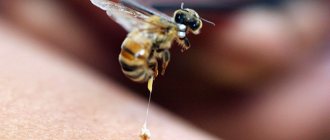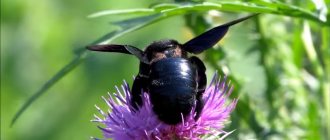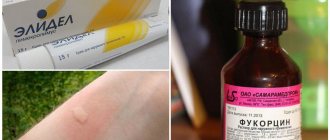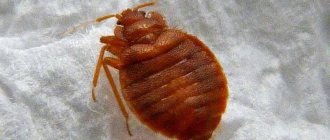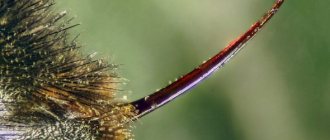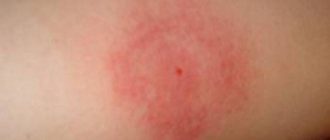Other interesting questions and answers
What is the point of a bee sting if it dies after it?
Why then do you need to sting:
- self-defense? not very effective, because it will die anyway...
- destroying the offender so that he does not touch anyone else - so her bite is not fatal))
the sting remains in the victim. Why?
Let's start with the fact that a bee does not always die after stinging someone. This is true for those species of bees that are equipped with a special sting - with strongly pronounced serrations. Not everyone has this. African species, for example, have a rather smooth sting, so they can easily sting an enemy several times without dying.
Additionally, most bees we encounter are social animals. They live as a family - a swarm, in which one individual bee plays one clearly defined role. In some ways, a bee family can be compared with a caste society, but with a more rigid assignment of the role to an individual organism (at the physiological level).
Worker bees and the queen are “equipped” with a sting.
The uterus needs a sting, however, only at the very beginning - when it makes the mating flight to create a new family. She uses it to fight other females and, naturally, does not die from it.
It turns out that worker bees usually and most often sting. They are in the bee family - nurses, nannies, builders, security guards. They use their sting to protect the family (and, in fact, the uterus), the home and the supplies collected in it.
This is quite logical. - everything for the preservation of the species and the further existence of bees: the queen gives birth to future offspring, housing preserves them, food allows them to grow.
So it is precisely for the sake of protecting the future kind that the bee protects the family and stings the one who appears to be an enemy. She doesn’t care what exactly happens to this very enemy: he will simply run away, develop a “conditioned reflex” - not to approach this or other bee dwellings again and not touch the bees - or die from poison. The main thing is to leave him alone and not attack.
At the same time, the bee itself “does not think” about self-defense or about the consequences for it personally of such behavior. Simply because it is not actually a full-fledged living being (it is not even capable of reproducing, since it is sterile). Only the family as a whole exists as a complete organism. A worker bee is a component of this organism that performs a specific function; her death after performing this function (in this case, protection) for the family is not critical and does not matter.
An almost complete analogy to the behavior of a worker bee stinging an enemy is a lymphocyte - a blood cell whose purpose is to destroy foreign cells and microorganisms. By killing the “stranger,” lymphocytes themselves die, but provide the body as a whole with protection from various diseases. The body receives benefits (immunity, recovery), and its small part - the lymphocyte - in no way “thinks” about its own death and “does not regret”.
Why does a bee die after stinging?
The bee has a jagged stinger, similar to a jigsaw. Therefore, when bitten, it gets stuck in the body of the bitten person and, as they correctly wrote, is torn out of the bee with all its intestines.
And a wasp, for example, has a sting like a needle, not a saw, it doesn’t get stuck, so the wasp can bite without fear of dying.
Wow, I found a bee sting in magnification... Yu K 3
Is it possible to swallow a wasp (bee), if so, can it sting inside the body and if so, what will happen to a person?
It is possible to swallow a bee if, for example, it gets stuck in jam. She can also bite inside, this is fraught with swelling of the laryngeal mucosa, asphyxia and quick death from suffocation. Quite a lot of people die from a bite to the throat; they can only be saved by installing a tracheostomy within 10-15 minutes after the bite.
Lev Ovchinnikov 40
Mosquito Now I killed a big red mosquito, I saw that it had a sting in its ass, can this mosquito sting?
Not a single mosquito can sting - mosquitoes do not have stingers. And the big red mosquito was a harmless female Longlegged mosquito. You were afraid of her female organ - the ovipositor...
Features of a bee sting
Usually, when people see a bee flying up, they start to really panic. The first reaction that most people have is to drive away the dangerous insect by waving their arms. But is it right to act this way? What to do if an unpleasant incident could not be avoided? Why does a bee die after being stung?
If you are bitten by a bee, you do not need to wave your arms, run, or scream. The bite lasts 1–2 seconds, after which the insect tries to fly away immediately.
Does a bee die after stinging a person?
The bee, hornet and wasp have similar body structures, but they differ significantly. The bee dies after being stung, but nothing similar happens with other stinging insects. What is the reason for this feature? Why does a bee die after stinging? The point is the special structure of the sting, the tip of which resembles a hook. In case of danger, the insect can attack the enemy and attack in its characteristic way, by inserting a sting.
The bee does not always die after being stung. Human skin, like animal skin, is hard and elastic. When the sting hits it, the hook clings tightly inside. The frightened insect quickly twitches, trying to fly away. At this moment, the lower part of the body is torn off along with the sting, and the intestines of the attacking bee partially remain at the site of the bite. Damage to the insect's internal organs leads to death.
Bee and its sting
Close-up of a bee sting.
A bee's sting is an organ at the tip of its abdomen that serves for self-defense and attack. The queen, the founder of the family, lays offspring with her. One bite, or rather the poison it contains, is enough to make rivals die.
As an inquisitive teenager, I watched as my grandfather was treated for osteochondrosis with bee stings in the apiary. Here’s the pattern: if a wasp bites, it quickly runs away, and a bee dies.
How does a bee sting work?
The bodies of bees differ - their structure depends on the functions performed in the family, so queens, drones and workers have different anatomy. The sting can be up to 4.5 mm long. It is necessary for protection from other insects and animals. In case of danger, the bee sprays poison that causes burning and pain.
The sting, consisting of a fixed and movable section, is located on the bee's abdomen. In a calm state, it is hidden under the joint. This weapon is attached to the body and intestines with thin films for protection. The fixed section includes an unpaired middle part - a sled about 2.5 mm long, looking like a trench. Their front part widens slightly, and the back, on the contrary, narrows and ends with a sharp groove. In front of the sled, arched lateral processes diverge, between which there is a fork with sting muscles. Elongated plates are attached to the processes from above.
Bees and their structure vary depending on the duties they perform in the hive. In any case, an insect bite does not pose a threat to human health. The only exception is the presence of individual intolerance.
The movable section includes two styles - these are thin needles, at the end of which there are notches. The queen bee has 5 such notches, while the worker bee has 10. Along the entire length of the stylet there is a large longitudinal notch that extends onto the roller of the sled. Thanks to this connection of stylets and sleds, movement is carried out. The cavity formed by them is a channel through which the poison flows.
A bee's life is not honey...
The basis for the coordinated activity of the entire hive is the worker bees. Physiologically, these are females with an underdeveloped reproductive system. They perform a whole range of vital functions:
- build honeycombs;
- clean the hive and protect it;
- pollen and propolis are harvested;
- collect nectar and process it into honey;
- feed and raise the brood;
- take care of the queen and drones;
- provide the family with water.
In what situations does a bee sting?
For those who plan to live in the country for a long time, this question is especially relevant. Bees use their weapons extremely rarely - only in exceptional cases, and not for attack, but for defense, when they encounter a serious threat. But there may be other circumstances:
- Strong smell. Sensitive olfactory receptors help to recognize the aroma of flowers over vast distances. An insect may attack if it senses something unusual and frightening - for example, the strong aroma of perfume or sweat.
- The smell of smoke. Instinctively, the insect senses danger, because such a smell may indicate a forest fire. Therefore, she tries to escape and in panic can sting everyone who meets on the way.
- Clothing in dark colors. Beekeepers note that bees react differently even to the color of clothing - dark shades cause aggression in them.
- Poison from other bees. If you are bitten by one bee, then others may attack - they will feel the poison, which will be a signal for an attack.
Consequences of a bite
A single bite will not have a serious negative impact on the life of the victim if there is no allergy. Only a few minutes pass from the incident to the appearance of the first symptoms. At first, pain is felt at the site of the bite, the skin becomes red, and swelling appears. The sting must be removed quickly, otherwise a blister will appear in its place. Redness goes away relatively quickly - within a few hours, but swelling can last up to 10 days.
It is important to provide assistance to the victim in a timely manner to avoid unpleasant consequences. The sequence of actions is as follows:
- Do not allow the area of skin that has been affected to be scratched to avoid the rapid spread of poison.
- A cold compress or ice is applied to the bite site, and the victim is given medications with antihistamine properties.
- The affected skin is treated with a soap solution. You cannot squeeze out the sting that remains under the skin; you need to carefully remove it with disinfected tweezers.
- You can try to reduce the pain after extraction using traditional methods. To do this, make a paste from crushed leaves of parsley, plantain and boiling water. A compress of pre-chilled olive oil helps relieve itching and reduce redness. Aloe juice effectively relieves swelling.
Multiple bites pose a serious danger, especially for people prone to allergic reactions. With a first-degree allergy, hives appear, severe itching and swelling appear, and body temperature rises. With a second-degree allergy, the functioning of the respiratory system is disrupted, spasms in the intestines and arrhythmia are possible.
The most severe consequences occur if a bee stings you on the tongue. In this case, the poison rapidly spreads through the mucous membrane of the larynx, which leads to swelling and difficulty breathing. If poison gets into the eyes, swelling, redness and watery eyes may also appear.
Benefits of bee venom
Bee venom is associated with painful sensations after a sting - burning and itching. But products made on its basis have a positive effect on the human body - nature has created many healing agents. Thus, thanks to the unique composition of bee venom, they increase hemoglobin levels, normalize blood clotting, lower blood pressure, and improve performance. The best effect can be achieved by combining the poison with useful health procedures - for example, sunbathing and swimming.
Methods of treatment with bee venom
Treatment can be carried out in different ways. Patients are given subcutaneous injections, ointments based on bee venom, and special baths are prescribed. Bee stinging is popular. It is important to carry out any procedures only as prescribed by an apitherapist, as there are many contraindications.
Bee venom is actively used in medicine for:
- vascular diseases;
- migraines;
- hypertension of the first and second degrees;
- intercostal neuralgia.
How can a person avoid a bee sting?
To avoid becoming a target for insects, it is better to follow simple rules:
- Do not use perfume in your summer cottage, so as not to attract bees with a strong aroma.
- In places where bees are likely to appear, it is better to wear light-colored clothing.
- Do not eat sweets or drink sugary drinks in possible places where bees appear, and also do not leave half-eaten fruits at your summer cottage in the summer.
- Try not to make sudden movements when you see a bee, so as not to scare it.
How to provide first aid and what to do after being stung by a bee, watch the video.
Now you know why a bee dies after stinging, and also how long a bee lives after stinging a person. You should not be afraid of single bites if you are not allergic to the venom of these insects. Try to follow simple safety rules and a dangerous incident is unlikely to happen. But if a peace-loving summer resident or city dweller is nevertheless attacked by a bee, then you should calmly provide first aid, information about which is presented step by step in this article.
To Caesar - Caesar's...
Over the course of a year, several generations of worker bees change in a bee colony. Each generation has its own physiological characteristics, life expectancy, behavioral and nutritional characteristics. The most dramatic differences are observed between summer and winter bees.
How long does a bee live? Those born in the summer do not live long - from 5 to 8 weeks. They feed on pollen only for the first 10–12 days of life while they work in the hive. You have to work in the field from hand to mouth, so the body fat layer of summer bees is practically absent.
How long does a bee born in autumn live? Their life expectancy is much longer - 6–8 months. They hardly feed the larvae, but feed heavily themselves. The fat body of winter bees is well developed and consists of several layers of protein and fat. The absence of field flights significantly reduces wear and tear on the body and, accordingly, prolongs the life of insects.
How long does a male bee live? The age of drones is also short-lived. Their well-fed, idle life, surrounded by the constant care of worker bees, lasts at most 8 weeks. At the end of the honey collection, the stingless males simply stop feeding and are persistently pushed out of the hive. Therefore, the brave bee hussars have only two options: to leave the family voluntarily and die of hunger, or (in the case of stubborn reluctance to vacate the living space) to be mercilessly killed by their own fellow Amazons.
How long does the queen bee, the guardian of the entire family, live? She is a true long-liver in the bee family. For 4 years she has been responsibly fulfilling the most important task of continuing the glorious bee family! Under favorable conditions, the queen is capable of laying more than 1,000 eggs per day.
Why does a bee die after being stung?
The honey producer's sting has a unique structure - at its tip there is something like a hook. And although the bee is quite peaceful, when it sees a threat, it is the first to attack the enemy and thrust its sting into his body. Whether a bee dies after being stung or not depends on what surface it inserts its sting into.
Animals and humans have elastic and hard skin. When a sting hits it, the hook firmly clings inside, and the insect, trying to immediately fly away, twitches sharply, and the lower part of the body comes off along with the sting. Due to damage to internal organs, the insect dies within a few seconds. If a bee attacks its own kind, i.e. insects, then it has a chance to survive. Insects have a chitinous cover, which is quite soft, and after a bite the bee can pull out the sting and hide.
How long does a bee live after stinging a person?
Once a person is stung by the shoulder, death occurs within seconds.
The lifespan of a bee after stinging a person is only a few seconds. In the event of an attack not on people and animals, but on insects with a soft chitinous cover, there is a high chance of surviving by easily removing the sting after a bite.
A bee may not always use its weapon. If there is a lot of honey in its abdomen, then it is unlikely to sting.
Consequences of a bee sting
After a bite, a person immediately feels a sharp, burning pain, which is comparable to the pain from a burn. A sting will be visible in the center of the wound, around which redness and swelling of the skin immediately begins. All this happens due to bee venom, which entered the skin through the sting. If the victim does not have allergies, then, apart from redness and discomfort, nothing bad happens.
However, if a person is susceptible to allergic reactions, swelling may occur and medical attention will be required. It is dangerous if the bite occurs on the tongue or lip, as they become very swollen and painful. Multiple bites are also dangerous, especially on the face. In addition to the fact that it will not look the best, it may also cause suffocation. In this case, you must immediately consult a doctor.
First aid for a bee or wasp sting
A bee or wasp injects poison into the human body using its sting. Therefore, the skin swells, turns red and hurts. If you have been stung by a wasp or a bee, you must urgently take action and provide first aid:
- Get the sting. This can be done using tweezers or a needle. The tweezers or needle should be wiped with a disinfectant solution, and after removing the tip, the skin area should also be disinfected.
- Apply a cooling compress or ice.
- Take an antihistamine (Eden, Claritin, Fenistil, L-cet, Diazolin, Erius, Zodak, etc.)
After the bite, pain and swelling can be felt for a long time. Wasp stings tend to be more painful than bee stings.
Children are often stung by bees or wasps:
- Firstly, children love to eat sweets, which attracts insects;
- Secondly, it is impossible to force children to calm down; they will wave their hands when they see a dangerous insect;
- Thirdly, children often play outdoors and can stir up a wasp’s nest; in this case, bites are inevitable.
Therefore, your first aid kit should always contain the following items to help your child:
- Antihistamine syrup. It is recommended to take it, even in the absence of signs of allergy, the syrup will relieve pain.
- Cooling ointments for insect bites (Moskitol, Psilo-Balm, Fenistil gel).
- You can apply skin-restoring creams to the bite area (Bepanten, Panthenol, Dexpanthenol, baby cream).
If such a nuisance happens to a child, do not panic, this will cause even greater fear in an already excited baby. Try not to panic and provide timely assistance to the child. Children are unlikely to have a strong reaction to the first bee sting. But this case may provoke insect allergies in the future.
Help with bee stings
There are terrible cases when a person is allergic to bee and wasp stings. The person's condition may be poor:
- The temperature may rise.
- Swelling extends more than 10 cm from the point of the bite.
- There is dizziness, shortness of breath, heavy breathing.
- Heart rate increases.
A person may not be aware of the fact that he has an allergy until he is stung by a bee. If the above reactions are observed, you should urgently contact an ambulance. Before the ambulance arrives, the following actions are important:
- If a bee has bitten a limb, apply a tourniquet 15 cm above the bite. You cannot hold the tourniquet for more than 45 minutes.
- Apply an ice compress to the area around the bite.
- Crush the suprastin tablet so that the victim can swallow it if the larynx suddenly swells.
Benefits of bee venom
As a medicine, bee venom has been used in medicine for a very long time.
- Its benefits are due to its unique composition:
- amino acids (18 out of 20 useful for humans);
- proteins;
- histamine;
- phosphorus;
- potassium;
- copper;
- calcium;
- hirudin;
- inorganic acids.
Therapy using bee venom is very useful in the treatment of neuralgia: radiculitis, arthritis, osteochondrosis. Due to the high content of amino acids, the poison improves brain function and helps the production of the “happiness hormone” - serotonin. This remedy is used in the treatment of various mental disorders: depression, asthenia, neuroses, sleep disorders.
Methods of treatment with bee venom
The most common and accessible method of treating poison is the use of various ointments based on it. They are rubbed into the skin for neuralgia, applied to wounds for better healing, and made into compresses.
People who do not suffer from allergies to bee products or the venom itself can use bee stinging. Apitherapists know exactly at which points the poison must be injected so that it brings benefit and does not harm.
Now there are also injections with bee venom, which can be used at any time of the year and injected exactly where needed. The poison is included in some tablets and solutions.
How can a person avoid a bee sting?
In nature, bees attack people very rarely. There is a risk of being bitten in an apiary when a person takes away their food, i.e. honey.
Experienced beekeepers use the following precautions:
- wear light, white clothes made of natural, smooth materials, since dark colors and fleecy fabrics irritate insects;
- a hat with a protective net is put on the head, and special mittens are put on the hands;
- they use smoke, sensing it, the bees fill their bellies with honey and can no longer sting;
- rub their hands with lemon balm or propolis, as these smells calm insects;
- do not make sudden movements or wave their arms;
- do not walk barefoot on clover and other low-growing flowers that insects love.
It is difficult to find a more unique and useful insect than a bee. In addition to the fact that it gives people honey, propolis, bee bread and many other products, thanks to its poison it also helps to heal from many diseases.
Interesting Facts
In Australia, scientists have begun experiments in cloning several varieties of grapes grown in cold regions. Climate warming, which is predicted for the next 50 years, will lead to their disappearance. Australian varieties have excellent characteristics for winemaking and are not susceptible to diseases common in Europe and America.
Convenient Android applications have been developed to help gardeners and gardeners. First of all, these are sowing (lunar, flower, etc.) calendars, thematic magazines, and collections of useful tips. With their help, you can choose a day favorable for planting each type of plant, determine the timing of their ripening and harvest on time.
You need to collect medicinal flowers and inflorescences at the very beginning of the flowering period, when the content of nutrients in them is highest. Flowers are supposed to be picked by hand, tearing off the rough stalks. Dry the collected flowers and herbs, scattered in a thin layer, in a cool room at natural temperature without access to direct sunlight.
The role of bees in pollination and nectar collection of different plant species
Oklahoma farmer Carl Burns developed an unusual variety of multi-colored corn called Rainbow Corn. The grains on each cob are of different colors and shades: brown, pink, purple, blue, green, etc. This result was achieved through many years of selecting the most colored ordinary varieties and crossing them.
In little Denmark, any piece of land is a very expensive pleasure. Therefore, local gardeners have adapted to growing fresh vegetables in buckets, large bags, and foam boxes filled with a special earthen mixture. Such agrotechnical methods make it possible to obtain a harvest even at home.
It became known why a bee dies after being stung
Due to the special shape of the sting, it is firmly stuck in the body of a person or other victim.
Why a bee dies after being stung has always been interesting for children to know. The situation is no less intriguing for adults. The answer is extremely simple, it’s not difficult to guess for yourself, but why nature works this way is not clear. Since bees and wasps are similar to each other, another question often arises: who dies after a sting - a bee or a wasp.
The honey insect is respected by people, and even from school they are taught to stay away from them and not to offend them. The creature is non-aggressive, always minds its own business - extracts nectar, carries it to the hive.
The person is not of interest, but in some situations there is a risk of being stung. The sting is located in the lower part of the abdomen; in a calm state it is invisible. Only in a situation where the insect senses danger does it use it. It differs in structure and appearance from the sting of the hornet and other relatives. It resembles a saw with wavy edges.
Once in the victim’s body, it gets stuck tightly and can only be removed by careful actions using tweezers. Bee and wasp, their stings How long a bee lives after being stung depends on how hard it tries to escape from the “crime scene.” There are situations when the insect remains alive.
Not all bees have a sting, and even if they do, they cannot always use it. An insect will not be able to bite if the abdomen is filled with honey; the structural features of the body do not allow it to appear outside. The queen or queen uses her sting only on special occasions. The “crowned” ones will not bite, even if you press on it.
Lethal weapons are immediately used when meeting a rival. Then the uterus also runs the risk of dying. Causes of death The wasp is capable of inflicting several bites within a minute, then flies away and continues to live.
The bee dies after being stung, so it prefers to fly away from the person rather than attack and leave a sting. Due to the special shape of the sting, it is firmly stuck in the body of a person or other victim. Having stung, the insect tries to quickly hide, makes a sharp jerk, but the sting remains. And everything would be fine, but part of the abdomen comes off along with the sting. Whether a bee will die after being stung depends on how quickly it tries to escape and how its body is damaged.
A bee dies after stinging if part of the internal organs remains with the sting. This condition is incompatible with life; she dies within a few seconds.
Bees
Only some species of bees have stings and venom glands. The sting is located at the end of the abdomen, but the bee cannot always use its “weapon”. The overstuffed abdomen simply will not bend to release the sting.
If the bee is calm, then the sting is hidden. In case of danger, the muscles tense, the abdomen bends, and the sting is exposed. At the moment of the bite, the belly moves down and then back. If the bee does not sting, the muscles relax and the sting “retracts” inward.
Bees use stinging tools not only for protection from humans. They use it when interacting with other insects or animals that pose a threat.
Is it true that a bee dies after stinging?
I heard that if a bee stings, it dies, even if you don’t touch it. But if it’s a wasp, then it remains alive and has no problems at all. Why is that? And is this really happening? Or is this just a superstition?
Yes, it is, and the reason for this is the structure of the bee. She sticks the sting into her victim, and then, when she tries to remove it, she only succeeds in doing so along with the internal organs, after which the bee dies. But if a bee stings insects whose body is covered with chitin, then it manages to safely pull the sting out of the bitten one without any damage, in which case it remains alive. That is, the skin of the bee's victim should not be elastic.
Yes, a bee has a jagged stinger, while a wasp has a smooth one. Therefore, if a bee bites a person, the sting gets stuck in his body and comes off along with part of the bee’s abdomen. The bee dies. The sting must be carefully removed from the wound, picked up with a fingernail or a needle, just do not crush the “bag” of poison, it will be on top. But the wasp doesn't care! She can bite as much as she wants!
Yes, in most cases, the bee bites people for real and plunges its sting deeply - which is why it itself soon dies. However, I have encountered situations where, having stuck a sting into a person’s skin, a bee still managed to remove it and flew away - that is, bites without deep penetration under the skin are also possible!
Yes, this is really true and I checked it on my own body, since I have been working with bees for 10 years. Everything here is in the structure and structure of the insects themselves and their stinging organs. Hence the difference.
Yes it's true. Once a bee stings, the sting remains in the body of the victim. After this, alas, she dies, as part of her body is torn off. The wasp simply does not have a sting, it simply bites and flies away quietly. Of course, I'm not talking about all types of wasps.
As stated above, the bee actually dies after it stings. Its sting is like a harpoon and it gets stuck in the skin. Trying to free itself, the bee, along with the sting, tears off part of its body, which leads to its death. It should only be clarified that this happens when a bee inserts its sting into the elastic skin. But if she is stung by some insect, she will remain alive, because... their body is covered with chitin, and the bee can easily remove its sting from there.
Most often, they actually die due to the structural features of their body. But there are exceptions; I was stung by the same bee several times, so you need to be careful with them.
Yes, a bee dies after stinging because its sting remains at the site of the sting. Wasps can bite many times and do not leave a sting at the site of the bite. I know this from personal experience.
Bees, at their own cost, try to see out the intruder of their peace, but there is a time when the instinct of self-preservation kicks in. This is the swarming period. At this time, the bees are more friendly, and experienced beekeepers inoculate a swarm on their bodies. There is a sort of beard of several thousand bees hanging and just purring. A collective bite from this family will immediately send you to the next world.
How long does a drone live?
Drone
Male bees are called drones. They do not work in the hive, their task is to fertilize the queen and protect her for some time. Basically, the hive needs them only in the summer. After completing their work, the drones are no longer needed and are kicked out of the hive. As a result, on average, a drone lives for 3-4 weeks, but there have been cases when they managed to survive for a whole year. The fact is that the drone can move to another hive and already there participate in the fertilization of the female.
